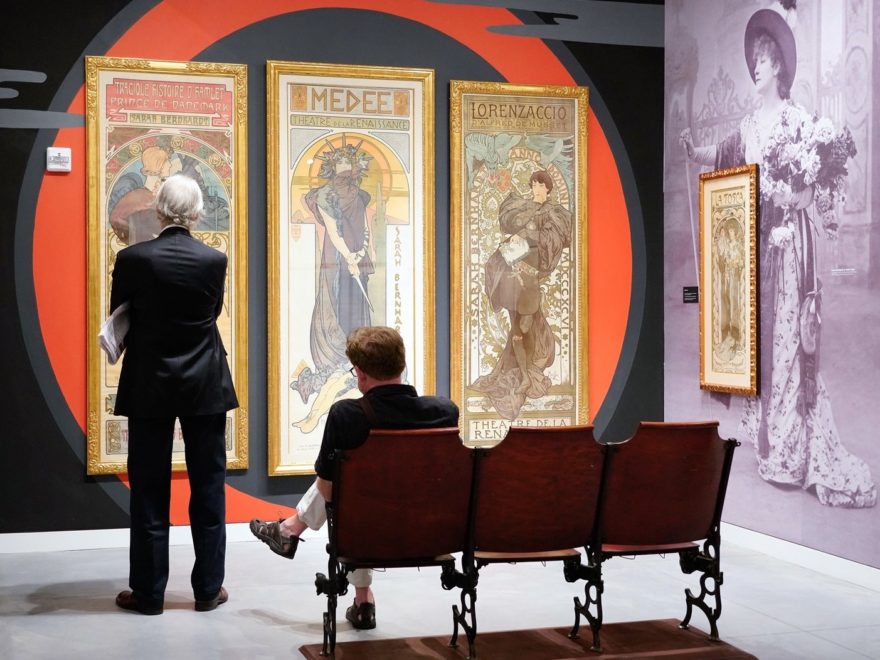News & Notes
Programming = “content” + “form” (guess which is more important)
It shouldn’t still surprise me, but it does. How can the NY Times preview of the Poster Museum in NYC ignore almost every aspect of that new cultural experience except the “what” — the objects that are displayed?
Then again, judging from the photos that accompany the article (see above), the museum’s founding curators may share the writer’s assumption: That “programming” an exhibition means little more than determining its content. That the form of a museum experience can be assumed, which is to say ignored. That the “how” side of the equation — how visitors encounter and interact with that content, how the role of the audience is construed and designed — either doesn’t matter or doesn’t call for any sort of creativity or innovation. It’s a given.
Which is exactly how museums like this keep their audiences small and specialized.
I wrote about the importance of the form-content duality here a few months ago, and I worked the problem again with a terrific cohort of museum leaders two weeks ago, when I taught a workshop on audience engagement at the Getty Leadership Institute. The question applies just as urgently to the performing arts, by the way: Many people at symphonies and theater companies, for example, still think of “programming” as synonymous with “repertoire” — the works that are performed onstage. As if sitting silently in your seat, reading your program, and dutifully applauding at the end of each movement or act were eternal, universal features of an arts experience. They’re neither, as a glance at the past (see Lynne Conner and Lawrence Levine) or the adjacent present (other forms of culture, entertainment, and participation) would confirm.
It’s not that “content” is unimportant. I’m a huge fan of the self-critique and rethinking now underway at arts ensembles and presenters about what plays and which playwrights to produce, and at art museums about what works and which artists to acquire and exhibit. That’s how we’ll decolonize these institutions and art-forms. But representation onstage or on the wall is a necessary, not a sufficient condition for relevance. We also need to decolonize the forms in which culture is produced and consumed: we need to get more representative and inclusive in our experience design.
Otherwise we’re going to continue catering largely to people who find those 20th century conventions of arts engagement perfectly congenial, if they notice them at all, plus people with a pre-existing interest in the content. (The latter is a formula for transient audience diversity in response to transient content diversity.)
The litmus test here is whether you can imagine wholly different experiences with the same content — an exercise that helps you focus on the form, the rest of the experience design. If you work at a museum, picture the same artworks, maybe even the same narrative or historical arc and some of the same interpretation facts and framings. But in one case the experience is fixed and passive, while in another it’s participatory and evolving. In one case it’s serious, in another irreverent. Constructed for solo experiences, or for social ones. Unmediated and contemplative or technological and multisensory. White-cube or immersive. Buttoned-down or spontaneous and messy. Neutral and “objective” or political and advocating.
If you work at a symphony, picture the same pieces played, but vary all those other attributes. (You may need to mentally dismantle your concert hall, not to mention your contract with the musicians union.)
Obviously, cultural institutions have some default preferences here, and the point is to recognize that they are preferences; not everyone shares them. And once you’ve acknowledged the form-content duality, it’s possible to admit that one can have a lousy experience with great content, or (and this is harder for most arts leaders to admit) a great experience with less-than-world-class content.
The funny thing is, practitioners of culture already know all this, on some level, because they prove it many times each year — in one-off events and programs, grant-funded innovation initiatives, and targeted experiences for under-represented audiences. They’re already playing with the form, and the resulting programs are often social, informal, participatory, playful, and fun in ways the organization’s mainstage, “core” offerings are not. One challenge, as my colleagues and I have found, is to help those practitioners stop thinking of such programs and events as pipelines to funnel those new audiences over to the traditional arts experience, and instead see them as alternative, valid, and sustainable experiences in their own right.
The far bigger challenge, of course, is to distill the principles by which those alternative, program-based experiences work and infuse them—gradually, creatively, with the help of nuanced evaluation and community co-creation—back into the core cultural experience: exhibitions, “regular” performances, etc. Nobody has quite nailed that yet, although some artists and some arts organizations have been experimenting in promising ways.
As always, let me know how this strikes you and what I’m overlooking. And stay tuned for a series of posts on the 6 Ps of Experience Design, a new framework in which this form-content duality plays a key role.
Photo: Rebecca Smeyne for The New York Times (special thanks!)

